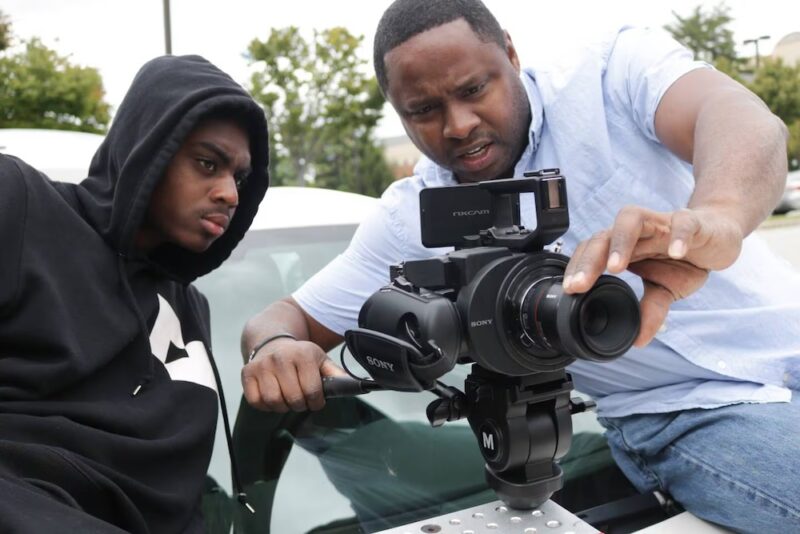“Work of Art: Abdi Farah,” at the Brooklyn Museum, is an uncanny echo of another current offering there, “Andy Warhol: The Last Decade.” Put another way, it presents the latest, not very satisfying results of Warhol’s grand experiment in art stardom.
The Farah exhibition opened on Saturday, a few days after the season finale of Bravo’s reality show “Work of Art: The Next Great Artist”; along with $100,000 in prize money, it rewards the program’s winner (and in this case, its most likable contestant). Taking its subtitle, “Luminous Bodies,” from a line in “The Empire Strikes Back” and its form from various strains of academic realism, it fills a glorified broom closet in the “World Famous Brooklyn Museum” (as Bravo describes the place). It looked much better on television.
Mr. Farah’s cast resin sculptures of fallen men have energy and a kind of grace. They have solid references, too, from Eric Fischl to Hank Willis Thomas (whose photographic series “Unbranded” has been installed nearby). But the basketball shorts and sneakers they wear are a conceptual crutch. They imply that the artist doesn’t trust his own ability to make gesture convey meaning.
The paintings are less impressive, tortured expressionist self-portraits with an obvious debt to Photoshop image filters. But before we go too much further, let’s remember that Mr. Farah is 22. If his art looks undergraduate, that’s because he received his B.A. from the University of Pennsylvania just last year.
How did we get from Warhol to this back-to-school moment?
The earnest awkwardness of the art in this exhibition, and on the “Work of Art” show in general, isn’t that surprising, but it’s nevertheless disappointing. At the outset, the program, whatever its hazards, seemed aligned with the art world’s exciting new fascination with performance and performers of all kinds, from Marina Abramovic’s MoMA survey to James Franco’s turn as a soap-opera star to the real-time commentary about “Work of Art” on the Facebook page of Jerry Saltz, New York Magazine’s art critic and one of the judges on the show (and also the husband of the New York Times art critic Roberta Smith). And it also seemed to present a challenge to business as usual, particularly the much-worried-over trend of art world “professionalization” that began in the boom years, when M.F.A. thesis shows were snapped up wholesale by Chelsea dealers.
But hopes were dashed when “Work of Art” turned out to be a cookie-cutter Bravo production, full of divas and toadies, trumped-up conflicts and flirtations, and complete with a signature, portentous sendoff (“Your work of art didn’t work for us”). And while the open casting call should in theory have suggested some alternatives to the standard career track, for every self-taught artist on the show there seemed to be two more who, like Mr. Farah, had art degrees and fellowships under their belts.
Strangely, the one place where the show could have benefited most from hewing closely to the “Top Chef” and “Project Runway” model — in its choice of competitive challenges — was where it deviated. The assignment that worked best, both as television and as a fair contest, was a straightforward commercial one: design a book cover for a Penguin Classic paperback. And some of the guest judges, like Will Cotton (who painted the confectionery clouds on Katy Perry’s latest album cover), had high-profile commercial experience.
Yet most of the challenges on “Work of Art” tended toward the vague and visionary and seemed aimed at capturing some of the art world’s clubbiness, sex appeal and mystery — and, in one memorably awful episode, “shock value” — at the expense of a clear-eyed look at art making. (Most of the episodes clung to a very 1980s myth of the artist as inner-child, à la Haring or Basquiat, and the casting of second-generation it-girl China Chow as an outlandishly attired host evoked long nights at the Mudd Club.) The judges never seemed to know exactly what they were looking for from week to week, celebrating verisimilitude in one episode and fretting about work that was too “literal” in another.
More problematic was the marginalization of curators — they were barely visible on the show — and the elevation of an auction house. Simon de Pury, the chairman of Phillips de Pury, was an unexpectedly fabulous “mentor,” doling out bons mots worthy of Tim Gunn from “Project Runway” with a soupçon of Swiss superiority. But the choice of a Phillips representative was peculiar; auction houses in general have long been seen as the enemies of the emerging artist, places where careers flare up and then fizzle. (At times, the format of “Work of Art” recalled another environment that’s typically hostile to art and artists: the art fair, where works are evaluated “within the first split second,” as Mr. de Pury described his instinctive judgments.)
“Work of Art” engaged curators only at the last possible minute; the Brooklyn Museum’s curator of contemporary art, Eugenie Tsai, conferred with the judges on the final selection of the winner and supervised the installation of Mr. Farah’s show. But a curatorial touch is light, if it’s there at all. Works that were shown in the spacious Phillips galleries on the show’s finale are crammed into the Brooklyn’s much smaller room with a minimum of editing.
Perhaps the producers feared that curators would make for deadly television, a suspicion that would seem to be justified by Ms. Tsai’s awkward slotting of the finalists into categories of conceptualist, feminist and “someone who is maybe taking on issues of race.” But without them, the show couldn’t faithfully represent the art world — or offer a plausible alternative to the system of value judgments that runs the commercial side of it.
The Brooklyn Museum has been pilloried for its agreement to mount the show — a decision that, though desperate-looking, isn’t unprecedented. In a text panel outside the gallery, the Brooklyn’s deputy director, Charles Desmarais, refers to the “tradition of the competitive ‘juried exhibition.’ ” He goes on to describe the 19th-century salon, but the shows that come to mind are the Guggenheim’s Hugo Boss Prize, the I.C.A. London’s Beck’s Futures, and any number of other commercially sponsored competitions that culminate in a museum exhibition that lends some degree of institutional credibility.
The museum’s affiliation with Bravo’s “Work of Art” is most worrying as a symptom of something bigger: a dampening of curatorial vision under the institution’s director, Arnold Lehman. Whether or not you agree with the museum’s efforts to broaden its appeal, which leaves it open to accusations of being overly populist, you have to acknowledge that it has been importing shows of contemporary art much more often than it generates them — and sometimes from compromising sources, as was the case with a recent exhibition organized by the Rubell Family Collection, the private museum of the Miami collectors Don and Mera Rubell.
Can “Work of Art,” the program, be fixed? Maybe. Any attempt would certainly have to address the time constraints put on the artists. The work in the finale, made over three months, was much better than anything in the earlier, rushed challenges. And if Mr. Farah had had three years — but then, he might as well get an M.F.A.
“Work of Art: Abdi Farah” continues through Oct. 17 at the Brooklyn Museum, 200 Eastern Parkway, at Prospect Park, (718) 638-5000, brooklynmuseum.org.





